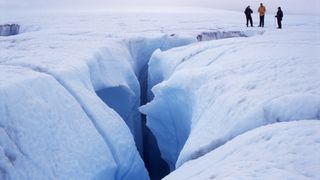After draining, lakes leave behind holes called moulins, which allow meltwater to continue to travel to the bottom of the ice sheet. (Image credit: Tony Waltham/robertharding via Getty Images)
Since satellite observation of the island began in the 1970s, the number of meltwater lakes dotting Greenland's ice has risen. These seasonal lakes have also started growing larger, and appearing at higher elevations, than in the past. These trends are linked with a general warming trend in Greenland, which has been experiencing
high rates of melt as the globe warms.
Meltwater lakes are a part of this story, but they've been underestimated, Christoffersen told Live Science. Between a quarter and almost a half of these lakes experience rapid draining that sends their water deep into the ice, but satellite observations don't capture these draining events very precisely. Researchers have also tended to see the lake losses as local phenomena, Christoffersen said, not events that affect the larger movements of the ice sheet.
But Christoffersen and his team have evidence that suggests these lakes do matter — a lot. In May 2018, the researchers published a paper in the journal
Nature Communications revealing that lakes tend to drain in clusters. The drainage of one lake can cause the ice surface to crack and fracture further, triggering other lakes to drain as well. The fractures left behind also act as conduits for further meltwater drainage, creating kilometer-tall waterfalls plunging into the ice.
"You actually have quite a big effect," Christoffersen said.
Vanishing act
On July 7, 2018, Christoffersen and his team were camped out near a meltwater lake called Lake 028 on Store Glacier when they noticed that the lake level was dropping fast.
"We could see a fracture that formed in the ice, and water was gushing into this fracture as it opened up," Christoffersen said.
Luckily, Scott Polar Research Institute doctoral candidate Thomas Chudley was at the scene with an aerial drone he'd been using to capture imagery of the glacial surface close-up. Chudley flew the drone over the lake at regular intervals as it drained, securing a detailed look at how the drainage occurred. The researchers published their findings Dec. 2 in the journal
Proceedings of the National Academy of Sciences.
One major lesson from the loss of Lake 028 was that though the lake didn't disappear completely, it still drained rapidly toward the base of the ice sheet, Christoffersen said. In satellite studies, researchers have largely ignored partial lake drainages, he said; the assumption has been that partial drainages occur when lake water flows out of the lake basin across the surface of the ice, where it isn't likely to have much effect on overall ice sheet movements.
The new observations suggest that this assumption is wrong. The lake's drainage sent more than 1.26 billion gallons (4.77 billion liters) of water toward the base of the ice, where it can do the most damage. The only reason the lake didn't drain completely was that the fracture didn't extend into the deepest part of the lake basin.
"That means that, in hindsight, we've been underestimating the ability of lakes to drain and create conduits that transfer water from the surface to the base of the ice sheet," Christoffersen said. The data from this research can be used to improve computer simulations that predict what the ice sheet will do in the future, he said.
"Understanding exactly how these fractures intersect lakes and how the lakes subsequently interconnect is going to play a key role in how we will model the ice sheet in a much more refined and realistic way in the future," Christoffersen said.





Comments
Post a Comment